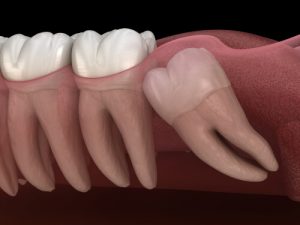If you’re unfamiliar about the term, a wisdom tooth is the oral cavity’s third molar, located at the back most part of the mouth. In most cases, this tooth erupts during early adulthood. But there are instances when your mouth doesn’t have any more rooms to accommodate more teeth. Therefore, horizontal impacted wisdom teeth will most likely occur.
Symptoms
There are cases where no problems are detected even with horizontal impacted wisdom teeth. Others though will experience symptoms. If it’s partially impacted, you’ll notice the tooth slowly breaking through the gums, making the gums easily noticeable.
Some people with partially impacted wisdom tooth will feel pain. This also causes food to get trapped, hence, making cleaning more difficult.
There are also incidents when the tooth gets infected. This will be manifested by pain, swollen jaw, bleeding or red gums, problems in opening the mouth and even bad breath.
If for some instance that the tooth does not break the gums, there’s a high possibility that it’s a fully impacted wisdom tooth.
Causes
The most common reason of having an impacted wisdom tooth is due to the jaw that has insufficient space to accommodate it. Chances are, the tooth develops and grows on a wrong angle, causing it to get impacted.
Most individuals who experience impacted wisdom are those with small jaw structure or the tooth development starts to take place at age 17 to 25. While there’s no effective method to prevent the wisdom tooth from getting impacted, the best approach is to make sure that it won’t complicate to other oral health problems. Therefore, it’s important to observe good oral hygiene.
Diagnosis
Taking a simple x-ray on your oral cavity especially your teeth can easily determine if your wisdom tooth is impacted. Aside from determining that the tooth is impacted, an x-ray can also indicate if there are other damages to the adjacent teeth or to the bones. Once diagnosed, the dentist will usually recommend surgical extraction accompanied with some risks and benefits.
Treatment
Especially if the wisdom tooth is causing discomfort or other dental problems, the dentist would usually recommend extraction. No worries though, it’s an outpatient procedure and you can go home on the same day.
During the procedure, local anesthetic is usually administered while there are cases where a sedative or general anesthesia would be needed. The procedure may take between 30 and 60 minutes, depending on how deep the impacted wisdom tooth is.
Post-extraction Recovery
Usually, it can take up to six weeks to attain full recovery from the tooth extraction. That’s the time you can go back to your usual activities of daily living. But before reaching full recovery, avoid eating hard foods, and opt for soft diet.
Pain, swelling and bleeding are also possible after the surgery. Therefore, it’s important for the dentist to provide instructions on what to do to relieve these occurrences.
Possible Complications
Since cleaning the wisdom tooth is very challenging especially if it’s fully impacted, the dentist would strongly suggest surgical removal. Otherwise, possible complications may take place such as gum disease, damage to adjacent teeth, dental caries and infection.

Leave a Reply